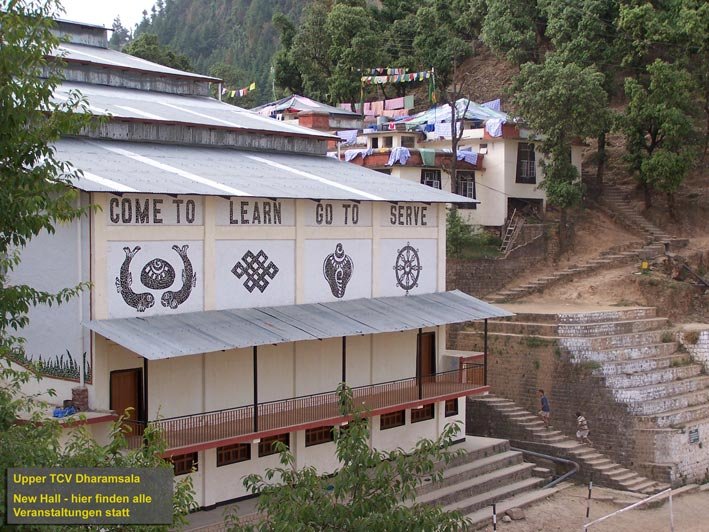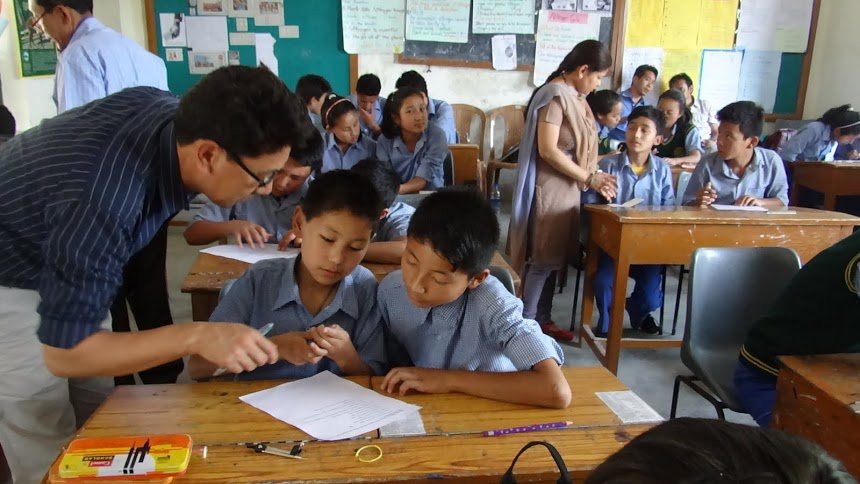
“Our work is to educate people that the ultimate source of the happy individual, happy family, happy community, and finally happy humanity—even happy world—ultimately depends on warm-heartedness. This is not just the concern of religious people; it is the concern of humanity as a whole.”
Tibetan Children Village School, Upper Dharamsala
After the Chinese occupation of Tibet in 1950 and His Holiness the Dalai Lama's relocation to India, addressing the needs of orphaned and separated Tibetan refugee children emerged as a top priority. Recognizing the importance of nurturing the younger generation for Tibet's future, His Holiness proposed establishing a center for destitute children in Dharamsala. On May 17, 1960, fifty-one children arrived from Jammu's road construction camps, suffering from illness and malnutrition. Initially cared for by Mrs. Tsering Dolma Takla, His Holiness' elder sister, the center, initially named "Nursery for Tibetan Refugee Children," received assistance from the Indian government, which rented Conium House for the children's accommodation. Originally providing basic care and later transitioning children to other residential schools, overcrowding led to the Nursery's expansion under the leadership of Mrs. Jetsun Pema. Through efforts to secure funding and support from international organizations, the Nursery transformed into the Upper TCV School in Dharamsala, evolving into a village-like community with its own school and homes.
Tibetan Children Village School, Lower Dharamsala
Lower TCV was established during a period of severe overcrowding at the Upper Tibetan Children's Village due to the mass exodus of Tibetans fleeing China's harsh policy in the 1980s. With many children in need of immediate care and rehabilitation, TCV once again took on the responsibility of providing for them. With initial funding from His Holiness and support from Herman Gmeiner Fonds Deutschland, TCV constructed a new school on a poultry farm it owned, which opened in 1984. Initially accommodating 100 newcomer children from Tibet, Lower TCV evolved into a fully residential school as other TCV branches absorbed more children. It aimed to address the educational needs of children whose parents could afford school fees, expanding and upgrading facilities up to class ten. Today, Lower TCV cares for 632 children and has grown into one of the best residential schools in exile, funded solely by Tibetan parents.
Tibetan Children Village School, Bylakuppe
In South India, the largest concentration of Tibetan refugees resides across five settlements. As the population grows and more destitute families migrate to these settlements, there is an increasing demand for additional schools, particularly day-care centers to support parents working on farms. Responding to this need, the Tibetan Children's Village (TCV) was established in Bylakuppe in 1981, spanning sixteen acres of land generously donated by the settlement. Through meticulous planning and effort, an idyllic children's village emerged, comprising 29 homes, two hostels, and comprehensive educational facilities up to class twelve. Additionally, TCV operates ten day-care centers in the Bylakuppe and Hunsur areas, catering to the needs of Tibetan settlers. TCV's steadfast commitment in South India has addressed numerous pressing needs within the community, significantly contributing to its development and well-being.
Tibetan Children Village School, Chauntara (formerly known as Patlikuhl)
In the early 1970s, TCV Patlikuhl school in the Kulu Valley was initially established on a temporary basis by Tibetan refugees at road work camps. However, its location near the River Beas posed a constant threat of flooding during the monsoon season, leading to significant damage. In 1995, the school was completely flooded for days, necessitating the temporary evacuation of children and staff to safer grounds. Recognizing the ongoing danger, plans were made to relocate and rebuild the school in a safer area. In 2001, 14.5 acres of land were purchased in the Tibetan settlement of Chauntra for this purpose. By May 2004, the children had relocated from Patlikuhl to the new school, which was formally inaugurated on November 21, 2004, by His Holiness the XIV Dalai Lama in the presence of sponsors who contributed to the construction of the project.
Tibetan Children Village School, Gopalpur
In response to the overwhelming overcrowding issue and continuous arrival of Tibetan children from Tibet, a new village was established in the early 1990s with support from SOS Kinderdorf International. Temporary accommodations were provided at TCV (Bir) until the completion of SOS Tibetan Children's Village at Gopalpur in 1997. Spread over thirty acres, the village now houses 1271 children in a self-sufficient community with 32 homes, a medical center, and separate hostels for boys and girls. Funding for the project is provided by Schweizer Freunde Der SOS-Kinderdorfer and Stiftelsen SOS-Barnebyer-Norge.
Tibetan Children Village School, Ladakh
In the 1970s, the Tibetan Settlement in Ladakh stood as the most remote and underdeveloped among Tibetan communities in exile, with nomadic refugee camps scattered along the Indo-Tibet border, isolated from the rest of the Tibetan population in India. Recognizing the dire situation, His Holiness the XIV Dalai Lama expressed deep concern, particularly for the fate of the children, and initiated a plan to introduce education and sustainable development programs in the region. With an initial seed fund of Rs.10,000 from His Holiness and land donated by the local Indian government, TCV embarked on building a children's village near Leh, Ladakh, in 1975. Today, TCV Ladakh has flourished into a thriving SOS Village with its own school and facilities, offering education from pre-school through grade ten. Out of the 24 children's homes, seven are dedicated to destitute Ladakhi children. Additionally, the region now boasts seven schools, a handicraft cum vocational training center, an agro-nomadic farm, and an old people's home, earning TCV Ladakh the nickname "oasis in the desert" and becoming a source of pride for both the Tibetan and Ladakhi communities, embodying the spirit of universal responsibility and care.
Tibetan Children Village School, Selakui
Construction of a new school project began in August 2001, approved by State Authorities, with a capacity for 500 children and selective admission based on merit for Tibetan students from various exile schools. Mr. Duke Tsering, a former TCV student, was appointed as the inaugural Headmaster. By early 2004, necessary staff recruitment was completed, and 198 students from TCV schools joined. In 2010, the school expanded to include secondary high school with a Science department. Admission is based selectively on merit, and today the school is one of the elite Tibetan institutions in Exile India, educating students up to class XII Science.
Tibetan Children Village School, Suja
In response to the surge of Tibetan refugees seeking freedom from suppression in the 1980s, the New Tibetan School was founded in Bir in 1986 under the Cabinet Secretariat of the Tibetan Administration. Initially accommodating 68 illiterate young adults, the school's management was later handed over to TCV in 1990. Confronted with challenges such as a lack of curriculum and infrastructure, TCV restructured the school and implemented new policy guidelines to standardize education. The success of the adult school led to the establishment of a new SOS Village in Bir, funded by SOS Kinderdorf International, with construction beginning in 1994. By 1995, the village welcomed 303 children from Tibet, easing overcrowding issues. Presently, the village consists of twelve children's homes and provides education up to the primary level, with ongoing efforts to alleviate overcrowding.








